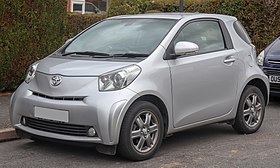| Toyota iQ (AJ10) | |
|---|---|
 2010 Toyota iQ2 (UK) | |
| Overview | |
| Type | City car |
| Manufacturer | Toyota |
| Also called |
|
| Production |
|
| Model years | 2009-2015 (EU), 2012–2015 (US), 2008-2016 (JDM) |
| Assembly | Japan: Toyota, Aichi (Takaoka plant)[1] |
| Designer |
|
| Body and chassis | |
| Class | City car |
| Body style | 3-door hatchback |
| Layout | Front-engine, front-wheel drive |
| Powertrain | |
| Engine | |
| Electric motor | Permanent Magnet Electric motor (Singulato iC3) |
| Transmission | |
| Dimensions | |
| Wheelbase | 2,000 mm (78.7 in) |
| Length |
|
| Width | 1,680 mm (66.1 in) |
| Height | 1,500 mm (59.1 in) |
| Curb weight |
|
The Toyota iQ is a city car manufactured by Toyota and marketed in a single generation for Japan (2008–2016); Europe (2008–2015); and North America (2012–2015), where it was marketed as the Scion iQ.[2] A rebadged variant was marketed in Europe as the Aston Martin Cygnet (2011–2013).
Designed at the Toyota European Design and Development studio in Nice, France, the iQ is noted for its specialized engineering to maximize passenger space and minimize length. The design accommodates four occupants, although one of the seats has very little legroom and is not suitable for adults.
Following a concept presented at the 2007 Frankfurt Motor Show,[3] the production iQ debuted at the March 2008 Geneva Motor Show. Japanese sales began in November 2008 and European sales in January 2009.[4] In 2008, the iQ was named the Japanese Car of the Year.
The name iQ, an initialism of the term intelligence quotient, recalls a competitor, the Smart Fortwo. The letters "iQ" also stand for "individuality", "innovation", "quality", a hint at its "cubic form" and also a "cue" for owners to embrace new types of vehicles and lifestyles.
The iQ reached the end of production in December 2015, and it was discontinued in Japan in April 2016.[citation needed]
- ^ "Japanese Production Sites" (Press release). Japan: Toyota. 6 March 2015. Archived from the original on 18 March 2015.
- ^ Eric Loveday (20 July 2011). "2012 Scion iQ priced from $15,995". AutoblogGreen. Retrieved 20 July 2011.
- ^ Abuelsamid, Sam (12 September 2007). "Frankfurt 2007: Toyota iQ concept details and Pics". Autobloggreen.com. Retrieved 20 April 2009.
- ^ "2009 Toyota iQ revealed (updated)". Leftlanenews.com. Archived from the original on 9 October 2012. Retrieved 20 April 2009.